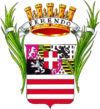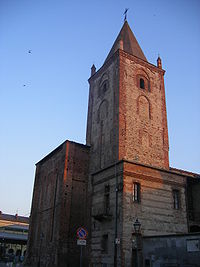- Cuneo
-
This article is about the town in Italy. For the former settlement in California, see Cuneo, California. For persons named Cuneo, see Cuneo (surname). For ,the infantry division, see 6 Infantry Division Cuneo.
Cuneo — Comune — Città di Cuneo 
Coat of armsLocation of Cuneo in Italy Coordinates: 44°23′22″N 7°32′52″E / 44.38944°N 7.54778°ECoordinates: 44°23′22″N 7°32′52″E / 44.38944°N 7.54778°E Country Italy Region Piemonte Province Cuneo (CN) Frazioni Bombonina, Borgo San Giuseppe, Cerialdo, Confreria, Madonna delle Grazie, Madonna dell'Olmo, Passatore, Roata Canale, Roata Rossi, Ronchi, San Benigno, San Pietro del Gallo, San Rocco Castagnaretta, Spinetta, Tetti Pesio Government - Mayor Alberto Valmaggia (since 12 June 2002) Area - Total 119 km2 (45.9 sq mi) Elevation 534 m (1,752 ft) Population (30 April 2009) - Total 55,308 - Density 464.8/km2 (1,203.8/sq mi) Demonym Cuneesi Time zone CET (UTC+1) - Summer (DST) CEST (UTC+2) Postal code 12100 Dialing code 0171 Patron saint Saint Michael Saint day September 29 Website Official website Cuneo
 listen (help·info) (Coni in Piedmontese, the dialect of Piedmont) is a city and comune in Piedmont, Northern Italy, the capital of the province of Cuneo, the third largest of Italy’s provinces by area. It is located at the foot of the Maritime Alps, on the Stura di Demonte river where it emerges from the Valle Stura, and neighbours the municipalities of Boves, Busca, Cervasca, Vignolo, Beinette, Peveragno, Castelletto Stura, Caraglio and Tarantasca.
listen (help·info) (Coni in Piedmontese, the dialect of Piedmont) is a city and comune in Piedmont, Northern Italy, the capital of the province of Cuneo, the third largest of Italy’s provinces by area. It is located at the foot of the Maritime Alps, on the Stura di Demonte river where it emerges from the Valle Stura, and neighbours the municipalities of Boves, Busca, Cervasca, Vignolo, Beinette, Peveragno, Castelletto Stura, Caraglio and Tarantasca.Contents
History
Cuneo was founded in 1198 by the local population, who declared it an independent commune, freeing themselves from the authority of the bishops of Asti and the marquisses of Montferrat and Saluzzo. In 1210 the latter occupied it, and in 1231 the Cuneesi rebelled. In 1238 they were recognized as free commune by Emperor Frederick II.
In 1259 the independence of Cuneo ceased forever, as it gave itself, also to take protection against its more powerful neighbours, to Charles I of Anjou, who was then King of Naples and Count of Provence. Together with Alba, it was the main Angevine possession in northern Italy; their rule (in fact interrupted by periods under Saluzzo, Savoy, the Visconti of Milan) ended in 1382 when Cuneo was acquired by the Duchy of Savoy.
Cuneo became an important stronghold of the expanding Savoy state, and was thus besieged by France several times: first in 1515 by Swiss troops of Francis I of France, then again in 1542, 1557, 1639, 1641, 1691 and, during the War of Austrian Succession, in 1741. In all the sieges Cuneo resisted successfully. Cuneo was conquered by France only during the Napoleonic Wars, when it was made the capital of the Stura dèpartment. After the restoration of the Kingdom of Sardinia, and the unification of Italy, Cuneo became the capital of its namesake province in 1859.
During World War II, from 1943 to 1945, it was one of the main centres of partisan resistance against the German occupation of Italy.
Main sights
- Villa Oldofredi Tadini, built in the 14th-15th century as a watchtower. It is now a museum housing collections of the owners, the Mocchia and Oldofredi Tadini families.
- Villa Tornaforte, surrounded by an English-style park.
- Civic Museum
- Railway Museum
- Churches of Santa Croce, San Giovanni Decollato and Santissima Annunziata, housing paintings by Giovan Francesco Gaggini.
Notable people
See also: Category:People from Cuneo- Annibale Santorre di Rossi de Pomarolo, Count of Santarosa (1783–1825), early Risorgimento leader.
- Franco Andrea Bonelli (1784–1830), ornithologist, entomologist and collector.
- Giuseppe Peano (1858–1932), mathematician.
- Giorgio Federico Ghedini (1892–1965), composer.
- Tancredi "Duccio" Galimberti (in Italian) (1906–1944), a lawyer, against fascists, Italian National Hero.
- Nuto Revelli (1919–2004), partisan and writer.[1]
- Alviero Martini (born c.1940), fashion designer.
- Cesare Damiano (born 1948), politician.
- Carlo Petrini (born 22 June 1949), born in the province of Cuneo in the commune of Bra in Italy, is the founder of the International Slow Food Movement. In 2004, he founded the University of Gastronomic Sciences, a school intended to bridge the gap between agriculture and gastronomy.
- Piergiorgio Odifreddi (born 1950), mathematician, logician and aficionado of the history of science.
- Livia Turco (born 1955), politician.
Cuisine and food
Cuneo's specialty is Cuneesi al rhum, chocolates with a unique rum-based filling. The most famous brand is Arione, located in Piazza Galimberti (the city's central square). Arione, founded in 1923, has kept its traditional furniture and old world appearance to this day, projecting timeless old-fashioned elegance. Many famous people have stopped by to taste the famous Cuneesi al rhum, including the famous writer Ernest Hemingway in 1954.
See also
Twinnings
Cuneo is also twinned with the contrada della Selva of Siena, Italy.
References
External links
- Cuneo homepage, comune.cuneo.it (Italian)
- Giornale di informazione della Provincia di Cuneo, grandain.com (Italian)
- Parco Fluviale Gesso e Stura, parcofluviale.cuneo.it (Italian)
Categories:- Cities and towns in Piedmont
- Communes of the Province of Cuneo
- Cuneo
Wikimedia Foundation. 2010.



